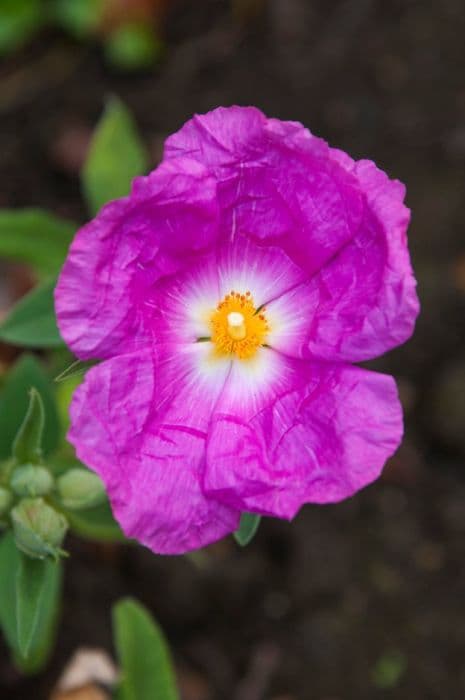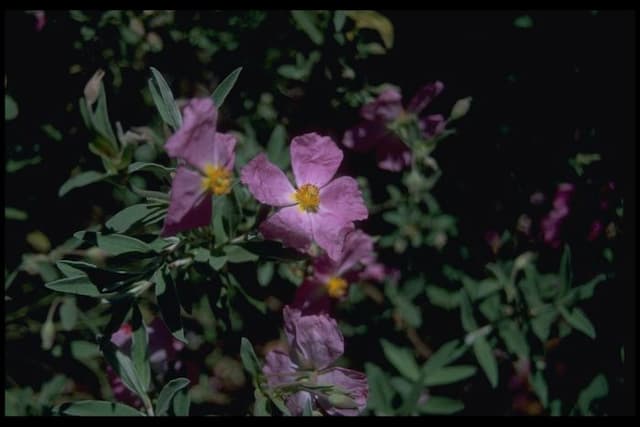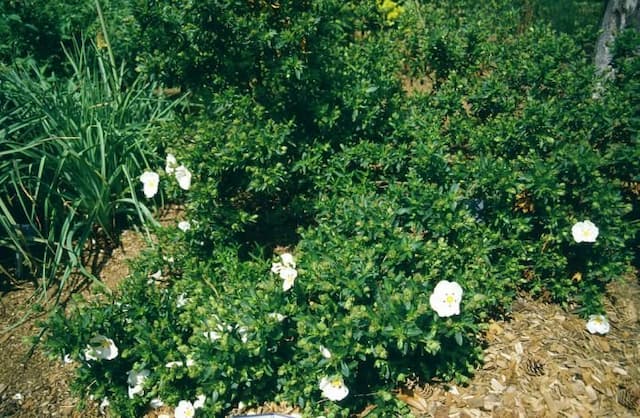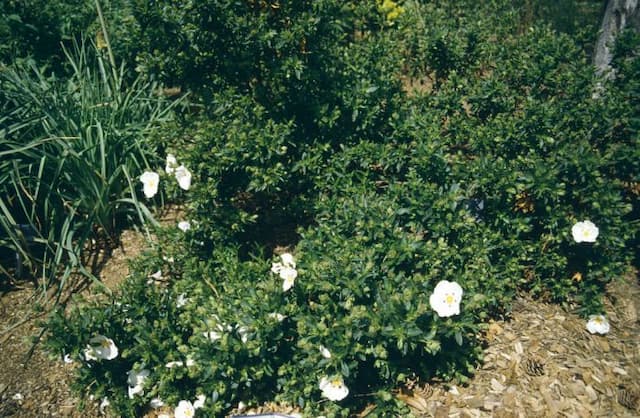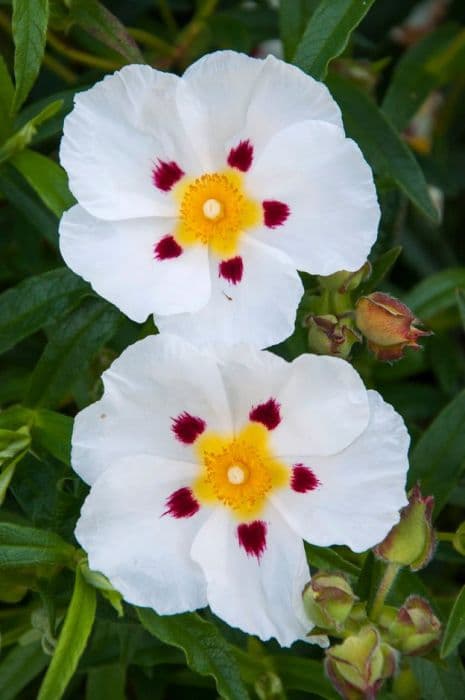Cretan Rockrose Cistus creticus

ABOUT
Cistus creticus, commonly known as the Cretan Rockrose, is a flowering shrub with a bushy, dense habit that makes it a distinctive plant in the landscape. The leaves of the Cretan Rockrose are dark green, slightly wrinkled, and have a leathery texture, which allows them to retain moisture and withstand the heat. They are lance-shaped and typically possess a sticky surface, which gives them a shiny appearance, especially under the sunlight. The flowers, which are one of the most striking features of the Cretan Rockrose, are showy and resemble tissue paper in texture. They are large, rose-like, and range in color from pale pink to deep rose, often featuring a yellow center created by a group of prominent stamens. Each flower has five petals that are delicate and may have a crinkled look that adds to their ornamental value. These blooms are typically seen in the late spring to early summer and they emerge from buds that are covered in a reddish-brown fuzz. The contrast between the dark green foliage and the vibrant flowers is visually appealing and attracts various pollinators. After flowering, the plant may produce a fruit which is a woody capsule, but it is less noticeable and not particularly ornamental. In general, the Cretan Rockrose presents a harmonious blend of robust, evergreen foliage and delicate, blossoming flowers, making it a popular choice for gardens and landscapes where a Mediterranean aesthetic is desired.
About this plant
 Names
NamesFamily
Cistaceae
Synonyms
Pink Rock-Rose, Cretan Rock-Rose, Cretan Rose, Cretan Cistus
Common names
Cistus incanus subsp. creticus, Cistus villosus var. creticus.
 Toxicity
ToxicityTo humans
Cistus creticus, commonly known as Pink Rockrose, is not widely recognized as a toxic plant to humans. There is limited information available regarding its toxicity, and it is not typically associated with poisoning if ingested. However, as with any plant, sensitivity varies with each individual, and some people may experience adverse reactions if they consume parts of the plant. In general, it is advisable to avoid ingesting plants not known to be safe for consumption to prevent any potential negative health effects.
To pets
Pink Rockrose (Cistus creticus) is not known to be toxic to pets. There is insufficient evidence to suggest that animals suffer from poisoning when ingesting this plant. However, as individual animals can have different sensitivities, it is still advisable to monitor pets and prevent them from eating large quantities of plants not intended for consumption. If any signs of illness occur after ingestion, contact a veterinarian.
 Characteristics
CharacteristicsLife cycle
Perennials
Foliage type
Evergreen
Color of leaves
Green
Flower color
Pink
Height
3 feet (0.91 meters)
Spread
5 feet (1.52 meters)
Plant type
Shrub
Hardiness zones
8
Native area
Mediterranean
Benefits
 General Benefits
General Benefits- Ornamental Value: Cistus creticus, commonly known as Pink Rockrose, is highly appreciated for its attractive, large, pink flowers that can enhance the aesthetic appeal of gardens and landscapes.
- Drought Tolerance: Pink Rockrose is well adapted to dry conditions, making it an ideal plant for xeriscaping and for gardeners dealing with water scarcity or wanting to reduce irrigation needs.
- Low Maintenance: This plant typically requires minimal care once established, making it suitable for novice gardeners or those with limited time for garden maintenance.
- Soil Stabilization: The robust root system of Pink Rockrose makes it effective for controlling erosion and stabilizing loose or steep soils.
- Attracts Pollinators: The flowers of Pink Rockrose provide a food source for bees and other pollinating insects, which are essential for the health of many ecosystems.
- Habitat Creation: This plant can create a favorable habitat for various wildlife species, offering food and shelter.
- Fire Resistance: Pink Rockrose is known to have a level of fire resistance, which can be beneficial in fire-prone areas as part of a fire-wise landscaping strategy.
 Medical Properties
Medical Properties- Antioxidant: Cistus creticus has compounds that may combat oxidative stress.
- Antimicrobial: The plant exhibits properties that can inhibit the growth of bacteria and fungi.
- Anti-inflammatory: It may help reduce inflammation in the body.
- Astringent: The plant’s extracts have been used to tighten and tone the skin due to its astringent qualities.
- Expectorant: Cistus creticus may help in expelling phlegm from the respiratory tract.
- Antiviral: Some studies suggest it might have antiviral capabilities, particularly against influenza viruses.
- Wound healing: Cistus creticus is used in traditional medicine to promote the healing of wounds.
 Air-purifying Qualities
Air-purifying QualitiesThis plant is not specifically known for air purifying qualities.
 Other Uses
Other Uses- Cistus creticus, commonly known as Pink Rockrose, is used in perfumery for its rich and complex scent reminiscent of amber and sweet balsamic notes.
- The leaves and stems of Pink Rockrose are often used as a flavoring agent in cooking, adding a unique herbaceous twist to various dishes.
- Due to its sticky resin, known as labdanum, Pink Rockrose is used as an adhesive in traditional mending practices.
- The resin is also employed in incense and aromatherapy for creating calming and grounding ambiance in a space.
- Pink Rockrose plants are sometimes utilized in dye-making processes for fabric, imparting a mild, amber-like hue.
- In landscaping, Pink Rockrose is used for ground cover to prevent soil erosion due to its hardy and low-maintenance nature.
- Gardeners plant Pink Rockrose to attract pollinators such as bees and butterflies, thereby enhancing pollination in the garden.
- The flowers of Pink Rockrose are used in the decoration of cakes and pastries for their edible petals and aesthetic appeal.
- The leaves of Pink Rockrose are sometimes incorporated into handmade papers, providing interesting textures and fragrances.
- In the art world, the resin from Pink Rockrose has been used as a medium in encaustic painting, giving the artworks a glossy finish.
Interesting Facts
 Feng Shui
Feng ShuiThe rockrose is not used in Feng Shui practice.
 Zodiac Sign Compitability
Zodiac Sign CompitabilityThe rockrose is not used in astrology practice.
 Plant Symbolism
Plant Symbolism- Resilience: Cistus creticus, commonly known as Pink Rockrose, demonstrates remarkable resilience as it is well adapted to dry, poor soils and can recover quickly from fires due to its seed's ability to germinate in response to heat.
- Healing: The Pink Rockrose has been used in traditional medicine for its antibacterial and healing properties, representing the ability to heal and soothe physical ailments.
- Beauty: With its lovely pink flowers, the Pink Rockrose symbolizes natural beauty and the appreciation of aesthetic qualities that bring joy to the senses.
 Water
WaterPink Rockrose should be watered deeply but infrequently as it is drought-tolerant once established. During the first growing season, water the plant once a week with about 1 gallon of water to help establish a robust root system. After that, reduce watering to every two to three weeks, allowing the soil to dry out between waterings. In hot, dry climates, you may need to water more frequently, but always check the soil moisture first. Over-watering can lead to root rot, so ensure good drainage and avoid letting the plant sit in waterlogged soil.
 Light
LightPink Rockrose thrives best in full sunlight, so it's important to plant it in a spot where it can receive at least six hours of direct sun each day. This plant is well-suited to south or west-facing locations where the sun is strongest. Avoid shady areas as insufficient light can lead to sparse blooming and leggy growth.
 Temperature
TemperaturePink Rockrose is a hardy plant that prefers temperatures between 60 and 75 degrees Fahrenheit for optimal growth. It can tolerate a minimum temperature of about 10 degrees Fahrenheit but will not survive in prolonged temperatures below freezing. Ideal growing conditions involve warm days and cool nights, as the plant originates from Mediterranean climates.
 Pruning
PruningPink Rockrose benefits from pruning to maintain its shape and encourage bushier growth. Prune in late winter or early spring just before new growth begins, removing any dead or damaged branches to promote healthy plants. Annual light pruning is often enough, however, cutting back more severely every few years can rejuvenate older plants. The best time for significant pruning is after the last frost when the plant is still dormant.
 Cleaning
CleaningNot needed
 Soil
SoilPink rockrose thrives in well-draining, gritty soil with added organic matter. Aim for a soil pH of 6.0 to 8.0 for optimal growth. A mix of equal parts potting soil, coarse sand, and peat or compost will create an ideal environment for the plant.
 Repotting
RepottingPink rockrose rarely needs repotting as it prefers to be slightly root-bound. Generally, you should repot it every 2 to 3 years, using the opportunity to refresh the soil mix and prune any dead roots.
 Humidity & Misting
Humidity & MistingPink rockrose is well-suited to low to moderate humidity levels and doesn't require any special humidity adjustments. It can tolerate dry air, which makes it adaptable to typical indoor environments without extra effort.
 Suitable locations
Suitable locationsIndoor
Place Pink rockrose in bright, indirect light indoors; avoid overwatering.
Outdoor
Plant Pink rockrose in full sun and well-drained soil; minimal care required.
Hardiness zone
8-11 USDA
 Life cycle
Life cycleThe life cycle of Cistus creticus, commonly known as the Pink Rockrose, begins with seed germination, which usually occurs in the spring and can be facilitated by fire-related cues, as the seeds often require heat or smoke to break dormancy. The seedlings establish themselves quickly, developing a root system and foliage during their first growing season. As the plant matures, the Pink Rockrose enters a vegetative stage wherein it grows to its full size, forming a dense shrub with tough evergreen leaves and stems. During the flowering stage, typically from late spring to early summer, the Pink Rockrose produces showy pink flowers that attract pollinators, and after pollination, it develops seed capsules. The capsules dry and eventually release seeds, completing the reproductive stage. Over time, the plant may enter a stage of senescence, particularly after several years, where growth slows and it may die back, relying on its seed bank for species continuation.
 Propogation
PropogationPropogation time
Spring-Early Summer
Propogation: Cistus creticus, commonly known as Pink Rockrose, is typically propagated from semi-ripe cuttings taken during the late summer. Most growers select healthy, non-flowering shoots and cut them to a length of 3-4 inches (7.5-10 cm). The cuttings are then stripped of the lower leaves, dipped in rooting hormone to encourage root development, and placed in a mixture of perlite and peat or a similarly well-draining potting medium. The cuttings are kept under partially shaded conditions and maintained at a consistent moisture level without being waterlogged. With the correct care, they will root in several weeks, ready to be transplanted the following spring into their permanent positions.
